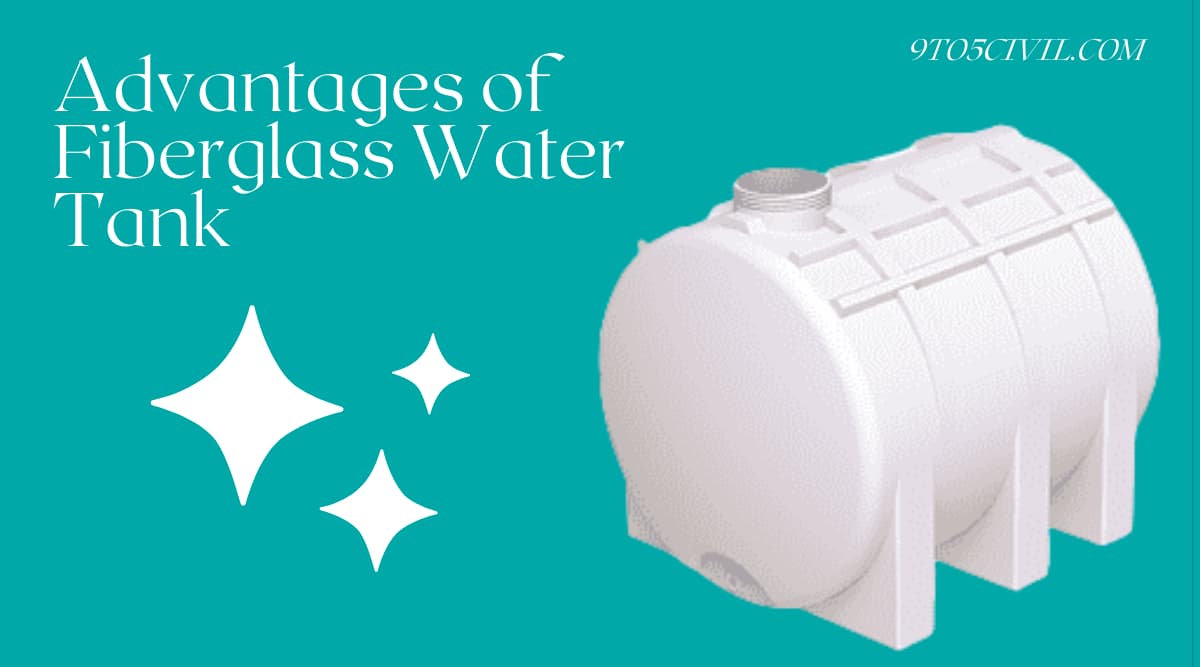
What Is a Fiberglass Water Tank?
A Fiberglass Water tank is a watertight container used to store water until it is needed. Fiberglass tanks can be placed above or below ground, or inside a structure.
A Fiberglass cistern tank can be constructed to collect and store rainfall or stormwater, as well as to receive water from a treatment plant or other sources.
The Fiberglass cistern’s pipe connections allow stored water to be delivered to sites of usage via plumbing systems.
Above Ground Fiberglass Water Tank
- Water storage might be a cost-effective option.
- Aesthetically pleasant alternative because the surface may be painted any color or even covered with a mural.
- Individually produced to meet your system’s requirements.
- Provides years of dependable performance due to its strength and longevity.
- It can be food-grade and NSF-approved for storing drinking water.
- Because of its fiberglass stability, it provides the finest protection against environmental harm.
Underground Fiberglass Water Tank
- UV exposure can cause the outside surfaces of a fiberglass tank to deteriorate.
- Because it must be brought to the site and craned into place, considerable access to the cistern location is required.
- Fiberglass tanks are made and distributed locally, which means they may be difficult to locate in your region or expensive to ship from their manufacturing sites.
- If you want a huge amount of rainwater storage, you’ll have to utilize many fiberglass tanks, which will waste room. Consider a round peg inserted into a square or rectangle.
Also Read: What Is a Concrete Cistern Tank? | Concrete Cistern Cost
How Long Do Fiberglass Water Tanks Last?
Fiberglass Water tank (FRP) is more than just a cost-effective material. In addition, FRP is a very durable material. There seem to be fiberglass boats that are over 60 years old which are still in operation today with little to no problems!
Nevertheless, as durable as FRP could be, there are some things to consider when determining how long your fiberglass tanks will last.
FRP tanks may well not endure as long as fiberglass yachts that are over 60 years old. This is due to the fact that water tanks or other fiberglass tanks are frequently in use for storing water.
The type of material stored in a fiberglass tank can have a big impact on how things are progressing. The more caustic the chemical is stored in a tank, the sooner it must be changed.
Tanks could also be accelerated in their decomposition by the atmosphere. Tanks are often more abrasive when subjected to higher pressures and temperatures.
Changes in pressure and temperature can also shorten the life of a tank. Tank lifetime is aided by high-quality materials and tank construction, as well as selecting manufacturers that regularly fulfill industry requirements.
In general, estimations regarding the lifetime of fiberglass tanks indicate that fiberglass water tanks endure the longest, lasting thirty to forty years on average. Fiberglass bleach tanks are next in line in terms of lifespan, lasting ranging from 10 to twenty years.
Acid and metal reaction tanks made of fiberglass or metal will only survive five to ten years.
There seem to be numerous measures that can be taken to ensure that their tanks exist as long as possible. One key thing to remember is to have the fiberglass tanks examined on a routine basis.
The simple rule of thumb is that even the most caustic chemical tanks contain, or a more hostile the circumstances they are maintained in, the further frequently the tanks must be checked. Yearly maintenance is recommended if tanks are exposed to harsher conditions. This is also strongly advised that you do never stray from the specs of the fiberglass tank.
Changing chemicals or environmental conditions without altering a tank can reduce its lifespan.
Most importantly, make certain that you hire experts who are well-versed in how fiberglass tanks work at all levels of construction. Fiberglass tanks that are properly designed and constructed will typically survive much longer.
Why Fiberglass Water Tank Is Preferred Over Metal Water Tank?
Choosing a material for your storage tanks is one of the most important considerations you’ll have to make upfront. Sure, there are numerous designs and models to choose from, but the material is still an important factor to consider!
The way a material may react with chemicals, how durable it is under various situations, and so on are all critical to the long-term success of your storage tank!
This implies that knowing all of your alternatives when picking the material for your storage tank might be beneficial. Metal is a well-known material, but it is not the only form of storage tank accessible! Indeed, there are several advantages to purchasing fiberglass water tanks over metal tanks.
The long-term strength of fiberglass tanks should not be disregarded! Many people do not believe fiberglass to be a very robust material. This is most likely due to the fact that metal appears to be inherently strong and is frequently utilized where strength is required, such as in the usage of numerous tools.
Metal, on the other hand, is often heavier than fiberglass. This means that fiberglass storage tanks are easier to move and less expensive to export than metal storage tanks. Because fiberglass is lower in weight, many people are unaware that it is also quite durable.
The fiberglass water tank is really incredibly corrosion-resistant, making it an excellent choice for storing corrosive compounds. You may enjoy the numerous advantages of choosing a lightweight material without sacrificing sturdiness when you work with fiberglass tank manufacturers.
Fiberglass tank has a plethora of advantages, many of which you and your organization may not be aware of. Fiberglass, for example, does not conduct electricity like a metal.
Electrical conductivity may be a safety and shock concern, hence this can be a significant benefit in terms of safety.
Fiberglass tank is also recognized for being very water-resistant, which is critical when it comes to keeping liquids. After all, keeping liquid items in a non-watertight storage tank might lead to severe leaks or contamination over time.
Finally, fiberglass water tanks are typically less expensive than metal tanks. Especially when you consider the cheaper transportation costs and the fact that fiberglass storage tanks are frequently more durable than metal in the long term (such as when corrosion is involved).
Also Read: Types of Drain Tile System | Interior Drain Tile | Exterior Drain Tile | Cost of Drain Tile System
Fiberglass Water Tank Price
The total cost of establishing a cistern system is determined by the system’s capacity, whether the water will be utilized for irrigation or interior domestic usage, and how the water will be transported (hose or underground pipes, gravity flow, or discharge pump).
A small, prefabricated cistern made of polyethylene or galvanized steel that holds 150-200 gallons and is typically used for landscape irrigation with a hose and gravity feed (no pump) will cost $150-$300, and a similar 300-350 gallon cistern made of fiberglass or a fiberglass/steel composite will cost $300-$660.
Larger water tanks (500 gallons or more) range in price from $500 to $3,000, depending on capacity and materials but may contain 10,000 gallons or more for $3,000 to $10,000 or more.
The location of the cistern, whether aboveground or underground, and whether the stored water will be used for irrigation or inside household consumption are all important considerations. According to the University of Florida, an average household cistern in Florida holds roughly 5,000 gallons.
A 550-gallon poly underground water cistern costs $645, and a 2,500-gallon poly underground water cistern costs $2,590; offers aboveground 3,000-9,000 gallon cedar cistern kits for $2,100-$8,800.
Depending on whether the water will be utilized for irrigation or human consumption, the entire cost of installation (including a discharge pump, trenching, pipelines, filter, and other features) can range from $2,000 to $20,000 or more.
Installing an aboveground 1,500-gallon plastic cistern costs about $1,500, while an underground 1,700-gallon cistern with a pump costs $5,000; and installing a 1,500-gallon aboveground plastic cistern system (with pump, roof washer, and filtration) costs $10,000 and a 1,700-gallon underground plastic cistern system costs $12,000.
Also Read: What is Drain Tile? | How to Install Drain Tile Around Foundation
Advantages of Fiberglass Water Tank
- The fiberglass water tank is constructed of high-quality fiberglass materials, has a long service life, does not pollute the environment and is safe for human use, has good anti-ageing performance, is safe and dependable, does not burn, is not conducive, and is antistatic.
- They will not fade even if they have been used for a long period.
- Fiberglass water tanks are constructed of gel coat resin, glass fiber cloth, and artificial fibers, with a high-density board surface that is corrosion resistant and long-lasting.
- They are lightweight, high-strength, and appropriate for water treatment and drainage system steel structure construction; the construction is easy and convenient to assemble, plug, and save time during construction.
- The pultrusion technology is used to make fiberglass water tanks with wall thicknesses ranging from 2.5 to 6.0 mm.
- It may also be utilized in the artificial molding hand lay-up process; tank wall thickness and size, length, and color can all be adjusted.
- Fiberglass water tanks have a wide range of applications in the petroleum, chemical, mining, power, maritime exploration, electroplating, shipping, water and wastewater treatment, cooling tower products, and aquaculture industries.
Disadvantages of Fiberglass Water Tank
- The tanks are translucent, allowing light to enter through partially. Algal growth can be triggered by the presence of sunshine. Most modern FRP tanks, on the other hand, have colours added to the glass to block sunlight.
- The hard glass-based substance can grow brittle and break over time.
Are Fiberglass Tanks Safe for Drinking Water?
Fiberglass Water Tanks Are a Robust and Reliable Storage Option for Potable Water, Non-Potable Water, Waste Water, and More.
How Much Do Fiberglass Water Tanks Cost?
8,000 Gallon Fiberglass Tank : $2,750
4,400 Gallon Fiberglass Tank: $2,000
2,500 Gallon Fiberglass Tank: $1,750
700 Gallon Fiberglass Tank: $600
Can Fiberglass Tanks Be Repaired?
Good quality materials and tank construction help maintain the life of the tank, as it can select manufacturers who consistently meet high industry standards. In general, estimates for the lifespan of fiberglass tanks indicate that fibreglass water tanks last the longest, lasting an average of thirty to forty years.
How Much Does a Fiberglass Water Tank Cost?
A 550-gallon poly underground water cistern costs $645, and a 2,500-gallon poly underground water cistern costs $2,590; offers aboveground 3,000-9,000 gallon cedar cistern kits for $2,100-$8,800.
How Long Does a Fiberglass Water Tank Last?
Thirty to Forty Years.
What Are Fiberglass Tanks Used For?
A Fiberglass Water tank is a watertight container used to store water until it is needed. Fiberglass tanks can be placed above or below ground, or inside a structure.
Like this post? Share it with your friends!
Suggested Read –
- What Is Foundation Spalling? | Foundation Spalling Repair Cost
- What Is a Concrete Cistern Tank? | Concrete Cistern Cost
- What Is Terracotta Cladding? | Terracotta Rain Screen Cladding
- What Is Pier Foundation? | How to Build a Pier Shed Foundation? | What Is a Concrete Pier Foundation?
- What Are Bored Piles? | Bored Piles Construction Process | Advantages & Disadvantages of Bored Piles
 Skip to content
Skip to content 